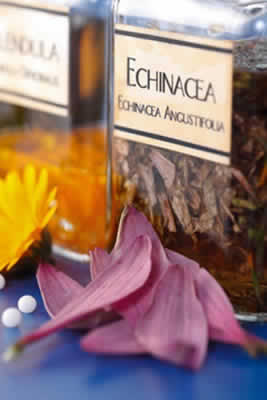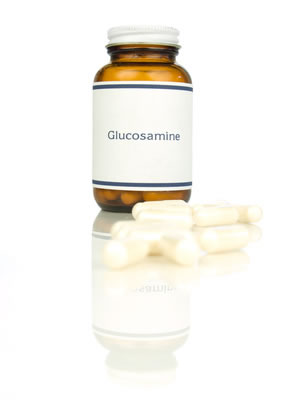The Echinacea flower, is native to the Midwestern region of North America. Both the herb’s upper parts and roots are used. For hundreds of years, the Plains Indians used it as an analgesic, an antiseptic, and to treat poisonous insect and snakebites, wounds, sore throat, and communicable diseases such as measles, smallpox and mumps. In the mid-19th and early 20th centuries, echinacea was used for treating infection with anthrax, snake bites and as a pain reliever. Echinacea was included in the US National Formulary from 1916 to 1950. But, after the introduction of antibiotic drugs, echinacea use fell out of favor.
Echinacea Benefits and Studies
The main species of echinacea that are used medically are echinacea purpurea, echinacea angustifolia and echinacea pallida. Echinacea purpurea is the species most frequently used for research. Echinacea extracts may reduce the duration of illness and decrease the severity of cough, headache, and nasal congestion. Therapy of upper respiratory infections including influenza, colds, tonsillitis, sore throat, and otitis media for the most widespread use of echinacea. Many European researches, primarily done in Germany utilizing both injectable and orally administered echinacea preparations support its therapeutic efficacy in these diseases.
Some studies have shown that echinacea were more effective than placebo in decreasing the symptoms caused by URI (upper respiratory infections). Echinacea was shown to stimulate phagocytosis, increase mobility of leukocytes, stimulate TNF and interleukin 1 secretion from macrophages and lymphocytes, and enhance respiratory activity both in vitro and in vivo. The alkylamide, alkaloid, and polyacetylene fractions are thought responsible for such immunomodulatory activities. Clinical trials have provided some inconsistent results about the effectiveness of echinacea, although the majority of studies support its use. The contradictory findings may be due to the wide range of echinacea products available, which can vary by species, part of the herb used in supplement preparation, dosage and
frequency of administration. On the other hand, the German Commission E (an official government agency similar to the FDA) approved echinacea root and juice extracts for treating respiratory infections and poorly healing wounds.
 Many research done by scientists in Germany showed that echinacea is effective primarily by increasing the number of white blood cells, thereby boosting the immune system and increasing the body’s ability to fight infections. Echincaea has healing, anti-microbial, antiinflammatory and nonspecific, immune-stimulant activity, primarily through the stimulation of fibroblasts and activation of phagocytosis. In other words, echinacea stimulates the overall activity of the cells responsible for fighting all kinds of infection. Unlike antibiotic drugs, which are directly lethal to bacteria, this herb makes our own immune cells more efficacious in attacking bacteria, viruses and abnormal cells, including cancer cells. The effect of echinacea is considered remarkable in its ability to stimulate the production and action of interferon. The chemical components of interferon are very important in activating white blood cells to destroy cancer cells and viruses. Lab experiments have confirmed that extracts of the echinacea root contain interferon-like effects.
Many research done by scientists in Germany showed that echinacea is effective primarily by increasing the number of white blood cells, thereby boosting the immune system and increasing the body’s ability to fight infections. Echincaea has healing, anti-microbial, antiinflammatory and nonspecific, immune-stimulant activity, primarily through the stimulation of fibroblasts and activation of phagocytosis. In other words, echinacea stimulates the overall activity of the cells responsible for fighting all kinds of infection. Unlike antibiotic drugs, which are directly lethal to bacteria, this herb makes our own immune cells more efficacious in attacking bacteria, viruses and abnormal cells, including cancer cells. The effect of echinacea is considered remarkable in its ability to stimulate the production and action of interferon. The chemical components of interferon are very important in activating white blood cells to destroy cancer cells and viruses. Lab experiments have confirmed that extracts of the echinacea root contain interferon-like effects.
Scientists in 1989 reported that echinacea may stimulate the immune system, especially the cells that monoclonal antibodies target. Giving mice an ethanolic extract of echinacea roots led to increased phagocytosis by macrophages and neutrophils. The rate was tripled by echinacea purpurea, and doubled by echinacea angustifolia or echinacea pallida. In a clinical trial, 24 healthy men were given oral echinacea purpurea (Echinacin®) administered as 30 drops, 3 times a day. After 5 days, isolated neutrophils from the echinacea-treated group demonstrated significantly increased phagocytic activity (120%) compared to the placebo group.
In a study, German scientists investigated 2 different doses of echinacea purpurea on 180 men and women who had developed a flu-like or feverish infection. Participants taking 450 mg a day had no more relief than those taking the placebo. But participants given 900 mg a day did better than the placebo group. They reported modest improvement after 3 to 4 days. In a clinical study conducted over 8 days with tablets made from a proprietary water-alcohol extract of the fresh herb (95%) and roots (5%) of echinacea purpurea, 55 participants were given the herbal preparation and 64 received placebo. Thirteen of the echinacea group were allowed to use additional approved medication, such as nose drops and the fever-reducing medication paracetamol. The examining physician concluded that the echinacea preparation was effective in 68% of the participants in reducing several of 12 symptoms participants self-assessed the efficacy of the echinacea purpurea at 78% of the cases. A clinical study conducted on 160 participants demonstrated that a daily dose of 900 mg of the extract of echinacea purpurea root was effective in shortening the duration of upper respiratory tract infections (pharyngitis, sinusitis, cough) in infected adults, whether of viral or bacterial origin. In another clinical study of 32 patients suffering from the common cold, therapy with a preparation including echinacea purpurea root extract, as well as vitamin C, eucalyptus leaf, rosemary leaf, and fennel seed, significantly reduced illness duration (by one day) and reduced the number of tissues used.
A study reported in the British journal The Lancet Infectious Diseases finds that the echinacea cuts the chance of catching a cold by 58% and can reduce the duration of colds by a day and a half. Scientists from the “University of Connecticut School of Pharmacy“, combined the results of fourteen different studies on Echinacea’s anti-cold effects. In one of the fourteen studies the scientists reviewed, echinacea was taken alongside vitamin C. This combination reduced cold incidence by 86%. When echinacea was used alone it reduces cold incidence by 65%. Even when patients were directly inoculated with a rhinovirus echinacea reduced cold incidence by 35%.
Echinacea may alleviate sore throat when taken in combination with sage, according to a 2009 study from the “European Journal of Medical Research“. For the study, researchers treated 154 sore-throat patients with a throat spray containing either sage and echinacea or chlorhexidine and lidocaine. Findings showed that the two throat sprays were similarly beneficial in reducing sore throat symptoms. Goldenseal usually used in conjunction with echinacea to bolster the immune system. The two herbs have synergistic effects that increase the overall effectiveness of the combination. Echinacea naturally contains important polysaccharides and phytosterols, while goldenseal contains strong alkaloids, including berberine and hydrastine.
A new study showed that echinacea has the capacity to enhance natural killer (NK) cells numbers, in aging mice, reflecting increased new natural killer cells production in the bone marrow, leading to an increase in the absolute numbers of NK cells in the spleen. Scientists at “McGill University“, studied the effect of taking echinacea intermittently, continuously, or just at the beginning of an disease. All the mice that received a daily dose of echinacea, throughout life, were still alive at 7 months, as opposed to the control mice, of which 79% were still alive. At about 13 months of age, the mice that consumed an untreated diet had a 46% survival rate while those consuming echinacea, had a 74% survival
rate. In a study in the U.S.A the pharmacological basis for the immunological activity of echinacea was studied by scientists at the Department of Medicine, University of California at Irvine Medical Center at Orange. Extracts of both panax ginseng and echinacea purpurea were examined for their capacity to stimulate cellular immune function by PBMC (peripheral blood mononuclear cells) from normal people and patients with either chronic fatigue syndrome or acquired immunodeficiency syndrome. Findings showed that the extracts enhanced cellular immune function of PBMC from both normal individuals and patients with depressed cellular immunity.
Any type of skin damage, whether caused by injury or infection can be treated with echinacea. One of the important actions of this herb is its property to inhibit a specific enzyme that weakens connective tissue cells when they are exposed to certain microorganisms. This enzyme is called hyaluronidase. The anti-hyaluronidase action of echinacea, particularly when applied as a poultice, can significantly prevent infection and enhance healing in burns, cuts, and abrasions. The anti-inflammatory effect of echinacea makes it a important remedy in fighting inflammatory skin diseases including eczema and psoriasis, and may even improve the body’s natural resistance to other conditions like herpes and
candida. The Echinacea root has been known to help the symptoms of psoriasis and bring relaxation to those that are in a constant state of discomfort. Of 4,598 patients with inflammatory skin problems (such as, eczema, burns, varicose ulcers of the leg, and a variety of skin wounds), including psoriasis, 85 percent were cured with topical applications of E. purpurea (leaves and flowers) salve (Wacker & Hilbig, 1978). In a German case series of 626 patients with minor burn injuries, all of whom were treated with an echinacea-containing ointment, of 628 adult patients with eczema, complete healing was noted within seven days for 82% (517). According to a study reported in April 2009 in the journal Intervirology, an extract from E. purpurea helps prevent recurrent infections with HSV-1 (herpes simplex virus type 1).One study showed that echinacea extract exerted an antiviral effect on the development of recurrent cold sores triggered by the herpes simplex virus when supplied prior to infection.
Echinacea have been shown to reduce the growth of Trichomonas vaginalis and lower the recurrence rates of Candida albicans infections. The favorable effect of echinacea purpurea leaf juice was showed in a German study of 203 women with recurrent vaginal yeast infections. All the participants were being treated with a topical econazole nitrate cream. Women using the econazole nitrate alone experienced a 60.5 % recurrence rate, while the women taking echinacea (oral Echinacin®) had a recurrence rate lowered to 16.7%. Human granulocytes and monocytes treated with echinacea purpurea extracts showed enhanced mobility and increased phagocytosis of Candida albicans by 30% – 45%. Purified polysaccharides from echinacea purpurea inhibited Candida albicans growth in vitro. In immunosuppressed mice, prophylactic therapy with echinacea polysaccharides prior to infection with Candida albicans reduced renal Candida load by 80%, compared to controls. Also, echinacea therapy prior to infection with a lethal dose of Listeria monocytogenes reduced the bacterial counts in both spleen and liver by 95% compared to the levels in control mice.
 Artichoke leaf extract (
Artichoke leaf extract ( In osteoarthritis, there is a progressive degeneration of cartilage GAG (glycosaminoglycans). Glucosamine is a important structural component within joint tissue and is the starting point of the synthesis of several major macromolecules including glycoproteins, glycolipids and glycosaminoglycans. Glucosamine facilitates the synthesis of glycosaminoglycans (GAGs), and therefore replenishing the availability of these molecules would slow the degeneration of cartilage. According to a study reported in the Jan, 2001 edition of the Lancet, glucosamine helps control osteoarthritis.
In osteoarthritis, there is a progressive degeneration of cartilage GAG (glycosaminoglycans). Glucosamine is a important structural component within joint tissue and is the starting point of the synthesis of several major macromolecules including glycoproteins, glycolipids and glycosaminoglycans. Glucosamine facilitates the synthesis of glycosaminoglycans (GAGs), and therefore replenishing the availability of these molecules would slow the degeneration of cartilage. According to a study reported in the Jan, 2001 edition of the Lancet, glucosamine helps control osteoarthritis.